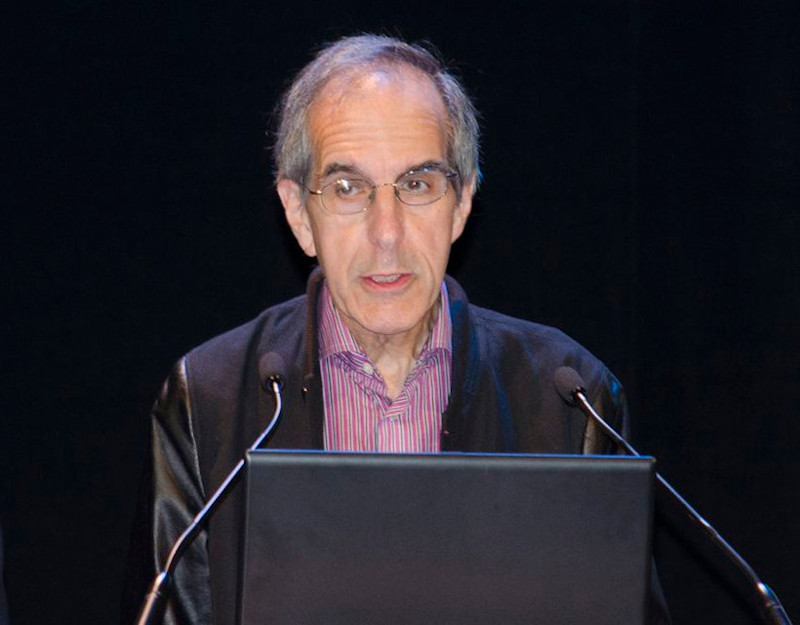Cyrus Chothia, FRS, (19 February 1942 - 26 November 2019), was an emeritus scientist at the Medical Research Council Laboratory of Molecular Biology (LMB) in Cambridge, where he was a fellow of Wolfson College.
He studied at Durham University, followed by an MSc at Birkbeck College, University of London, a small college but famed for its involvement in the development of structural biology and x-ray crystallography, being the home of such luminaries as J.D.Bernal, Aaron Klug and Rosalind Franklin. This was followed by a PhD at University College London supervised by Peter Pauling, son of Linus Pauling. Cyrus was one of the founding fathers of structural bioinformatics and made a particular contribution in the antibody field. Amongst others, he worked with Nobel prize winner, Michael Levitt, Joel Janin, Alexey Murzin, Tim Hubbard and Anna Tramontano, but he is perhaps best known for his work with Arthur Lesk. His PhD students included a number of people who have gone on to make major contributions in bioinformatics including (amongst others) Alex Bateman, Steve Brenner, Mark Gerstein, Julian Gough, Sarah Teichmann, and Bissan Al-Lazikani.

Back in the early 1970s, Wu and Kabat had demonstrated the presence of hypervariable sequence regions in antibody variable domains that they suggested would form structural loops or complementarity determining regions (CDRs) that come together in 3D to form the binding site. This was confirmed when Poljak solved the first antibody crystal structure and it was assumed that the CDRs would also be extremely variable in structure. I first met Cyrus in the late 1980s when I was doing my DPhil in Oxford on modelling antibody combining sites with Anthony Rees. By that time, around eight structures of antibodies, or Bence Jones light chain dimers, were available and Cyrus, together with Arthur Lesk, compared these. They found that, with the exception of the third CDR of the heavy chain (CDR-H3), the structures of the remaining CDRs were remarkably conserved. Further they proposed that the presence of certain 'key residues' - either within the CDRs, or packing against them - would define the conformation [PMID: 3090684], [PMID: 3681981], [PMID: 2687698]. To be frank, Tony and I didn't really believe it. After all, there were potentially billions of antibody sequences and they had looked at fewer than 10. Cyrus and Arthur came to visit us in Oxford and I remember sitting in The Eagle and Child with them discussing these ideas. Cyrus was always modest and completely accepted that they may be wrong, but of course they turned out to be largely correct. As more structures became available, the rules evolved with the importance of other positions being recognized [PMID: 2118959], but the principle was completely upheld. When we published a paper on key residues in 1986, I spoke to him about one of the outliers that appeared not to follow the rules. His view (which was almost certainly correct!) was that the crystal structure was wrong. More recent analysis by ourselves and others has suggested that the rules aren't always as precise as might once have been thought and the requirements for framework mutations outside the key residues in order to achieve good binding in antibody humanization supports the view that the precise conformation is influenced by other residues and the detail of the environment around the CDRs.
Cyrus introduced a definition of the 'structural loops' in antibodies. These are frequently referred to as the 'Chothia CDRs', a term that he did not like as, in his view, the CDRs were the sequence-variable regions defined by Wu and Kabat, while his definition related to regions that were structurally variable and he would not presume to redefine what had been done by Wu and Kabat. In fact, his definitions changed over his various papers as more structural information became available. He also introduced the Chothia numbering scheme for antibodies which was based on Kabat numbering, but modified the insertion sites in CDR-L1 and CDR-H1 to be structurally correct. Unfortunately in 1989, they made an error such that the insertions in CDR-L1 were placed after residue L31 rather than L30. As another example of his humility and modesty, I happened to referee a paper of theirs in 1997 and recognized this error. He guessed that I was the referee, contacted me, and immediately accepted the correction.
While I have focussed on his work on antibodies, he was widely known for his work in many areas of understanding protein structure. He was elected as a Fellow of the Royal Society (FRS) in 2000, for having "shown how the amino sequences of proteins determine their structure, function and evolution". To name just a few of his contributions, he developed the SCOP classification of protein structure with Alexey Murzin [PMID: 7723011] and the SUPERFAMILY database with Julian Gough. He studied multi-domain proteins [PMID: 15093836], protein packing [PMID: 10388571] and was involved in functional annotation of more than 60,000 cDNAs from the mouse transcriptome [PMID: 12466851]. As well as his work on the conformation of the CDRs, he examined the packing of VH and VL domains in antibodies [PMID: 4093982] and examined the evolution of immunoglobulin domains in general [PMID: 7175935]. With Bissan Al-Lazikani, he published his final paper on canonical classes of antibody CDRs [PMID: 9367782], but then extended this into T-cell alpha-beta receptors [PMID: 10656805]
Cyrus made enormous contributions to our understanding of protein evolution in general as well as of the structure of antibodies. He will be hugely missed by the scientific community, and by me personally. His science and the many well-known scientists who did their PhDs with him or were influenced by him, are a huge and lasting legacy.